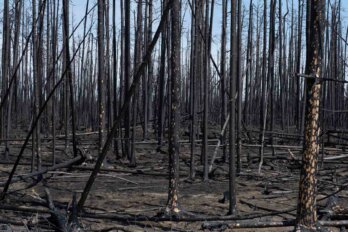June 2024—a flurry of metaphorical headlines out of Canada’s wealthiest province: “Alberta shuts down energy ‘War Room,’” “Calgary declares state of emergency due to water distribution facility crisis,” “Former Calgary mayor Naheed Nenshi named Alberta NDP leader in landslide victory,” “Devastated by Stanley Cup loss, Edmonton Oilers fans are still holding hope for team’s next act.” But there was one quieter headline that emerged as a harbinger: “Alberta’s coal power era comes to an end.”
Last month, Alberta didn’t just announce it had transitioned entirely off coal as an energy source; the province kicked the fossil fuel six years ahead of a wildly ambitious schedule. The scale of achievement this represents defies exaggeration—and contains a warning for oil fans everywhere.
In 2015, when Alberta’s newly elected NDP government unveiled a plan to phase out coal power by 2030, the province relied on coal for over half its electricity. Albertans were burning more of it than ever before. The industry employed over 3,000 people in twenty municipalities and First Nations, generating over $3 billion a year in revenue. The plan to end all this provoked a furious response. Jason Kenney, then hoping to become leader of Alberta’s Progressive Conservative Party, called it a “reckless attack on Alberta’s economy” that would impose “a cost of billions, perhaps ten billion dollars, to Alberta taxpayers.” He was wrong. What’s more, by the time he became premier in 2019, he was already powerless to stop what the NDP had set in motion.
The most immediate lesson is that climate policy matters: Alberta wasn’t running out of coal in 2015, nor had they found a cheaper alternative. The only reason to stop burning it was to lower Alberta’s carbon footprint; the province was responsible for 59 percent of the nation’s power-sector emissions. So it negotiated a $1.36 billion payout to coal-power producers, funded by a provincial carbon tax on large industrial emitters, along with hundreds of millions to support coal workers and communities through the transition. Nine years later, Alberta’s electricity emissions have been cut in half. Andrew Leach, an energy and environmental economist at the University of Alberta, told the Calgary Herald it was “arguably the largest emissions-reduction policy in Canadian history.”
There’s also a second, more urgent, takeaway: what happened to coal is coming for oil next.
Virtually every major analyst that isn’t an oil company (and even some of them, like BP) now expects global demand for oil to peak around 2030, if not sooner; McKinsey, Rystad Energy, DNV, and the International Energy Agency all agree. This places Canada in a uniquely vulnerable position. Oil is Canada’s biggest export by a mile, a vital organ of our economy: we sold $123 billion worth of it in 2022 (cars came in second, at just under $30 billion). Three quarters of that oil is exported as bitumen—the most expensive, emissions-heavy form of petroleum in the market and therefore the hardest to sell. That makes us incredibly sensitive to fluctuations in global demand. Think of coal as the canary in our oil patch.
That’s hard to do in the glare of the current global oil boom. The world consumed a record amount of oil in 2023, translating into unprecedented profits for suppliers, including those in Alberta. This bonanza has spurred companies to expand production further still. The United States Energy Information Administration expects global supply to grow by 1.1 million barrels per day, or BPD, through 2024, and by 1.8 million BPD in 2025.
The country leading this charge is Canada. Our current output of 4.9 million BPD is forecast to reach between 5.2 million and 5.4 million by the end of this year, a bigger leap than that of any other nation. Oil’s already massive grip on our economy is becoming a stranglehold. It accounts for a fifth of all commodities we sell abroad; together with gas, royalties from oil earned provincial governments $33 billion in 2022 (the last year for which data is available), and the industry directly employed about 150,000 Canadians. We need oil. Our prosperity depends on it. And that’s the problem—but not because of climate change.
People have been exaggerating reports of oil’s death for decades. In the 1970s, the Organization of the Petroleum Exporting Countries, or OPEC, cut off America from its supply, and US president Jimmy Carter put solar panels on the White House. In the 2000s, the notion of peak oil exploded as the price of oil surpassed $100 (US) per barrel for the first time in history. Then the US went all in on fracking, and scarcity became a glut. In 2020, the COVID-19 pandemic forced a pronounced dip in consumption that many interpreted as a permanent turning point, only for a post-pandemic rebound to prove them wrong. Predicting the arrival of peak oil is a good way to make yourself look foolish. But it’s more foolish still to pretend it isn’t coming, sooner now than ever. As with the end of coal, the end of oil won’t come because the world is running out. Climate concern accelerated government research and development around renewables, as well as subsidies to help companies in this sector scale up; just like how the oil sands got their start as a publicly funded venture, policies like heat pump subsidies and electric vehicle mandates have brought the world to the precipice of multiple clean-energy tipping points. Now we’re far enough along that the market can take it from here.
Solar power is already the cheapest form of electricity on earth. As of 2022, growth in solar capacity alone surpassed that of all other energy sources combined. In 2025, renewables will supplant fossil fuels as the world’s number one form of electricity. The clean power they provide is a prerequisite for cleaning up the transportation sector, which is currently oil’s biggest customer, with more than 40 percent of oil going to road travel. Electric vehicles already comprise over 10 percent of new car sales worldwide, and governments covering a quarter of the world market have mandated 100 percent EV production by 2035. China, leading the world in both renewables and electric vehicles, expects its oil demand to peak between 2026 and 2030.
“Before a tipping point, the force in the system is trying to hold back the transition,” explained Simon Sharpe, author of Five Times Faster: Rethinking the Science, Economics, and Diplomacy of Climate Change, in an interview with the BBC’s Future Planet last year. “But beyond the tipping point, actually, it’s reversed and the momentum is with the new technology. It’s growing fast, and it’s benefitting from these really strong, reinforcing feedbacks—the more people buy it, the more people invest in it, its cost comes down, it improves, and then more people want to buy it, and this keeps going . . . that’s when the transition really takes off.”
Alberta just saw this happen with coal, the dirtiest and most replaceable of all the fossil fuels. The same forces are coming for oil.
This time, 150,000 jobs and tens of billions in government revenue are on the line. Responsible leadership would help Canadians prepare for this reality, as Alberta’s NDP government tried to do for coal country in 2015. What we’re getting is the opposite. After the NDP was voted out in 2019, Alberta’s United Conservatives cancelled the transition funding for coal communities; this year, the party imposed strict restrictions on renewable energy, effectively banishing wind power from three quarters of southern Alberta. The federal Liberals make nice gestures toward clean energy, but nothing remotely compares to the $34 billion they spent on the Trans Mountain pipeline expansion, which started flowing on May 1; that project just unlocked the world’s single greatest increase in oil production, raising Canada’s output by up to half a million BPD.
We’re now the last G7 nation whose emissions are still rising. That’s almost entirely due to oil sands expansion. Even the world’s number one oil producer, the US, has managed to drop its emissions 17 percent below 2005 levels while expanding its production. Unlike Canada (but very much like China, the EU, and our other G7 partners), the US has made enormous, New Deal–level investments in the energy transition.
We’re not the only oil-endowed country trying to get while the getting’s good. Just about everyone is. What makes us unique is how proudly we’ve failed to plan for our next act.
With thanks to the Trottier Foundation for helping The Walrus publish writing on climate change and the environment.





